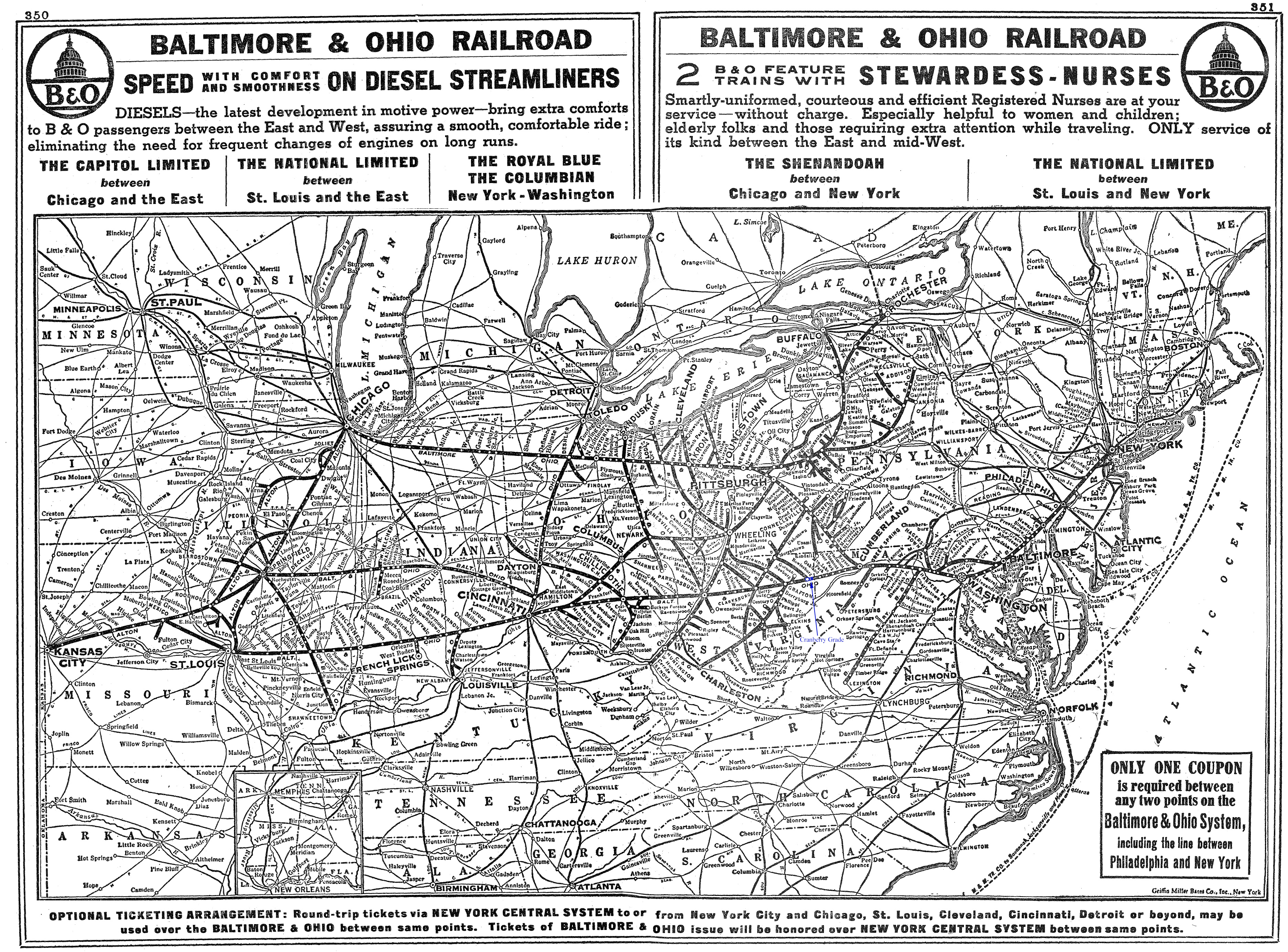B&O's Cranberry Grade
Last revised: October 10, 2023
By: Adam Burns
In the annals of American railway history, the Baltimore & Ohio's Cranberry Grade occupies a significant role. Running through the rugged terrain of West Virginia and Maryland, it's an impressive feat of railway engineering and a testament to the industry's pioneering spirit. The story of the Cranberry Grade is a study of innovation, determination, and continuous improvement.
The dream of crafting the Cranberry Grade started in the mid-19th century. The initial construction began in 1851, sparked by Baltimore & Ohio's expansion ambitions. B&O, a prominent American railway company, had a vision—to strengthen its connectivity and boost the region's industrial economy.
The B&O had no less than four major mountains to cross west of Cumberland, Maryland; one of the best known is Cranberry Grade between Terra Alta and Rowlesburg (M&K Junction). This 12-mile section of the B&O's main line tops out at a tortuous near-3% grade and still requires helpers under successor CSX Transportation today.
While the B&O's St. Louis main line west of Clarksburg was downgraded and abandoned in the mid/late-1980s, CSX still maintains the route to that point, which includes the Cranberry Grade segment.
The railroad handles primarily general merchandise and coal movements over the line and continues to reach the Ohio River via the B&O's old "Short Line" between Clarksburg and New Martinsville.
Photos
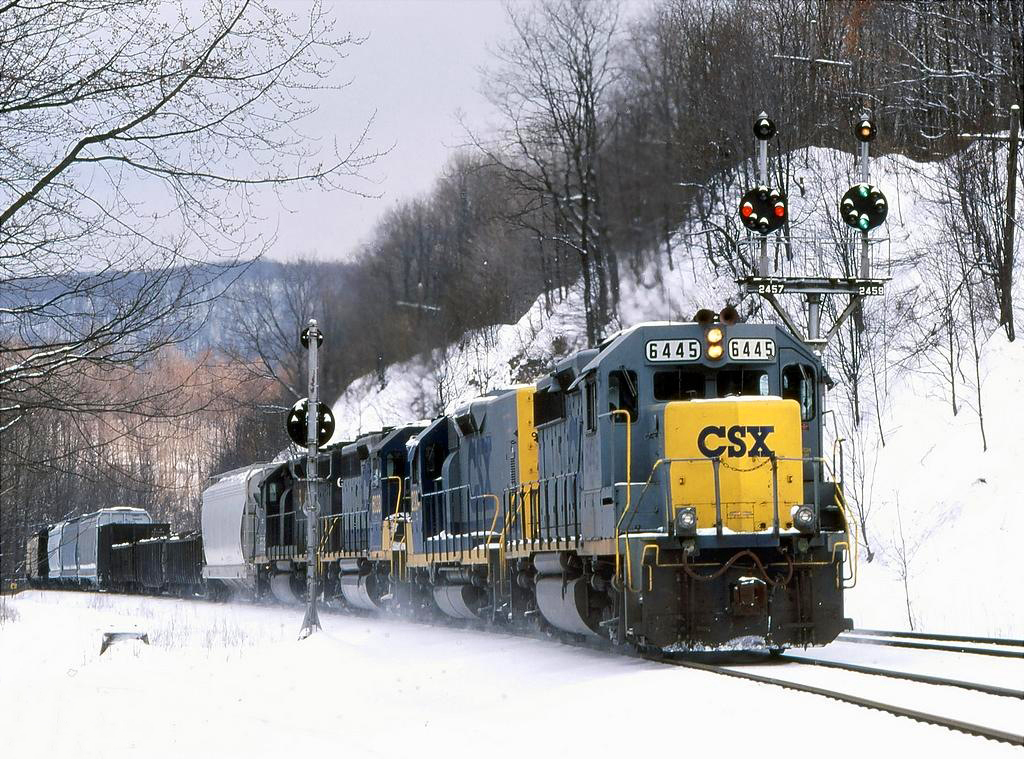 A trio of CSX Geeps, led by GP40-2 #6445, assaults Cranberry Grade with eastbound freight Q316 battling upgrade through the snow near Rodemer, West Virginia (Graveyard Curve) on March 9, 1995. Wade Massie photo.
A trio of CSX Geeps, led by GP40-2 #6445, assaults Cranberry Grade with eastbound freight Q316 battling upgrade through the snow near Rodemer, West Virginia (Graveyard Curve) on March 9, 1995. Wade Massie photo.History
The Baltimore & Ohio had reached Cumberland by November of 1842. However, it remained stuck there for eight years before progress continued westward toward the Ohio River.
With new president Thomas Swann taking the helm on October 11, 1848 the railroad's march further westward began. In 1849 the railroad began taking construction bids to build the line and by 1850 work had started.
After an arduous period of building under challenging circumstances, the Cranberry Grade's completion date was marked on July 25, 1852—a proud moment in the history of the Baltimore & Ohio.
Map
The railway network's extension, which included the Cranberry Grade, was a mammoth project. Though precise accounts of the total cost are elusive, the entire B&O line, including the Cranberry Grade, represented a significant economic investment for the period.
By December of 1852 the B&O had reached then Wheeling, Virginia on the banks of the Ohio River. To get there required 11 tunnels and more than 100 bridges. This was the B&O's original main line which passed rural hamlets in northern West Virginia. Today, this region remains relatively unpopulated.
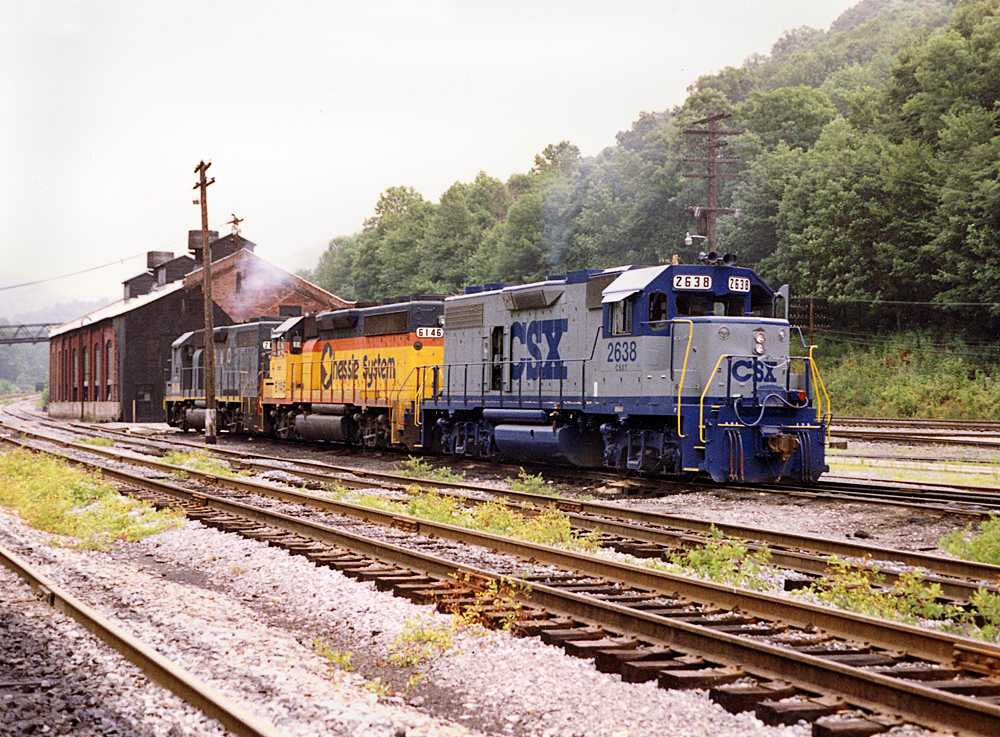 Helpers are still stationed at M&K Junction in Rowlesburg, West Virginia to assist eastbound freights. Here, three CSX Geeps await their next assignment on July 14, 1988. The B&O engine shop was closed by the date of this photo. Wade Massie photo.
Helpers are still stationed at M&K Junction in Rowlesburg, West Virginia to assist eastbound freights. Here, three CSX Geeps await their next assignment on July 14, 1988. The B&O engine shop was closed by the date of this photo. Wade Massie photo.Construction
From Piedmont, Maryland to Grafton, Virginia alone had required the B&O to cross four major mountains including (from east to west):
- Seventeen-Mile Grade (Piedmont - Altamont)
- Cranberry Grade (Terra Alta - Rowlesburg)
- Cheat River Grade (Rowlesburg - Tunnelton)
- Newburg Grade (Tunnelton - Grafton)
The grade was the railroad's second crossing over the Allegheny Mountains and featured a ruling grade of 2.84%. Specifically the B&O crossed Backbone Mountain, whose summit was located at the eastern end of the grade near Terra Alta.
The line began to steepen significantly east of McMillan and features the 180-degree Graveyard Curve, the B&O's version of Horseshoe Curve.
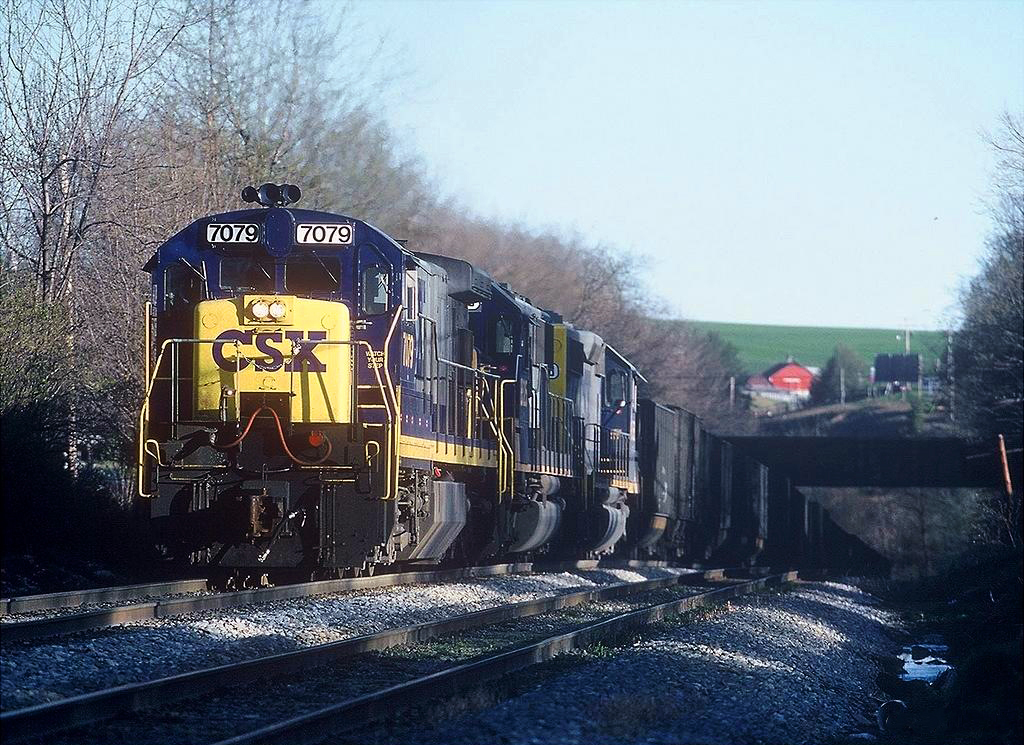 Taken nearly twenty years earlier than the photo below, CSX C30-7 #7079 has reached the summit of Cranberry Grade at Terra Alta, West Virginia with eastbound loads of coal on April 24, 1994. Note how steep the line is here! Wade Massie photo.
Taken nearly twenty years earlier than the photo below, CSX C30-7 #7079 has reached the summit of Cranberry Grade at Terra Alta, West Virginia with eastbound loads of coal on April 24, 1994. Note how steep the line is here! Wade Massie photo.Operation
From Terra Alta at milepost 335.8 Cranberry continues westward until milepost 348.1 at Rowlesburg. However, for the B&O making the eastward climb over the grade begins east of M&K Junction at milepost 347.4 where the railroad had a small maintenance shop and engine facilities.
This location was often photographed by railfans due to its easy access. The junction gained its name because of the Morgantown & Kingwood Railroad, which once connected with the B&O.
The M&K opened in 1907 hauling predominantly coal between Rowlesburg and Morgantown, interchanging this traffic with the B&O at both locations.
By 1920 the B&O had gained full control of the line and it remained a through route until 1987 when sections of it were abandoned. Today, virtually the entire line, known as the Kingwood Subdivision by CSX, has been abandoned.
Along with interlocking towers at M&K Junction and Terra Alta, during the steam era the grade featured a third located at Rodemer.
This was due to the installation of the third track by the B&O between Rodemer and Terra Alta after 1910. With dieselization occurring in the 1940s the railroad was able to remove the Rodemer interlocking in the 1950s.
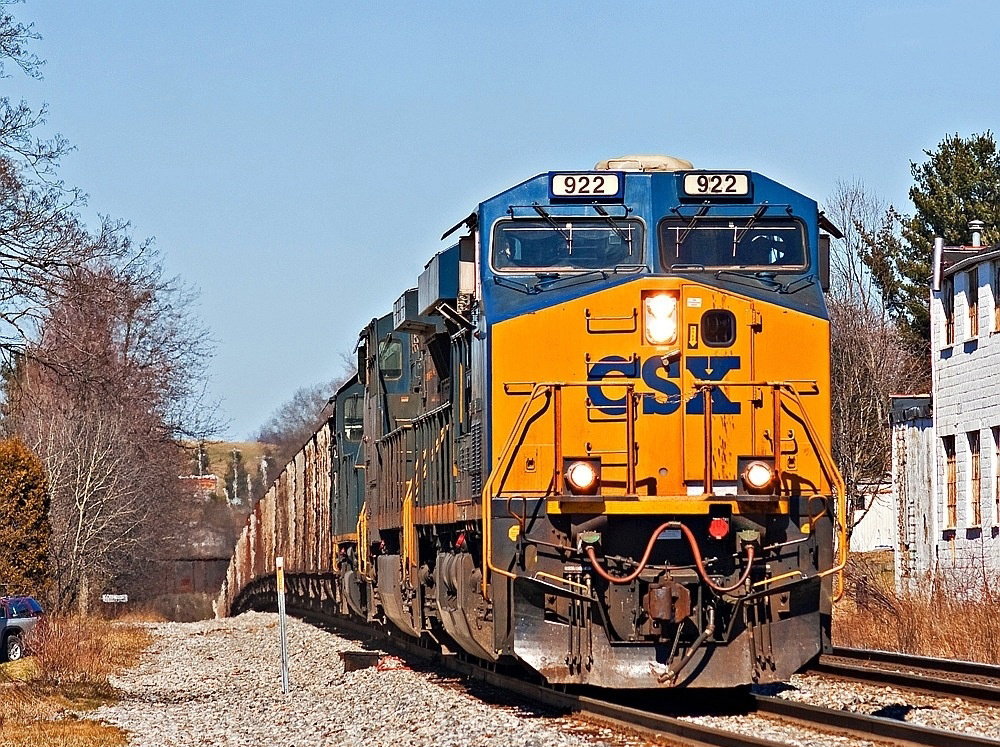 CSX ES44AC #922 crawls to the top of Cranberry Grade at Terra Alta, West Virginia with an eastbound coal dra on March 10, 2012. Loyd Lowry photo.
CSX ES44AC #922 crawls to the top of Cranberry Grade at Terra Alta, West Virginia with an eastbound coal dra on March 10, 2012. Loyd Lowry photo.Operations over Cranberry Grade were a sight to behold, especially if you were lucky enough to witness the action during the steam era with double-headed 2-8-8-4 Class EM-1s pounding up the grade and pushers shoving just as hard on the rear.
The sound was deafening and unforgettable. During the diesel era the Baltimore & Ohio had just as much trouble moving a train over the 12-mile grade requiring numerous locomotives, usually cut in to the train at various stages.
Moving into the present-day CSX era not much has changed as the Class I is still forced to use up to eight locomotives to get a heavy freight over the grade.
Legacy
While the Baltimore & Ohio as a separate entity no longer exists, its legacy lives on in the modern railway era under the stewardship of CSX Transportation. Acquiring the B&O in 1987, CSX incorporated the Cranberry Grade into its comprehensive network, recognizing its strategic value.
Today, the grade remains a crucial part of CSX Transportation's network. Even with the difficulties presented by the steep inclines, it is a vital artery for freight transit in the region.
The grade boasts a bustling freight corridor, allowing CSX to connect the various industrial bases spread along the B&O network while also providing a vital link to the broader nation, echoing B&O's original vision.
The challenges faced during the construction of the Cranberry Grade were not limited to its initial build. The steep gradient posed significant operational challenges for both the Baltimore & Ohio and CSX Transportation.
Throughout its time with the B&O, the Grade saw a range of locomotives tackling its steep ascents, including innovative steam locomotives and later, diesel engines, each leaving its mark on the history of this fascinating stretch of track.
Despite the advent of modern technology and evolving locomotives, the Cranberry Grade retains its reputation as a challenging stretch of track under CSX Transportation.
The susceptibility to harsh weather conditions, coupled with the steep ascent, has frequently required modern trains to depend on extra power units, reminiscent of B&O's early operations.
This persistent challenge has inspired innovative solutions. CSX Transportation has invested heavily in technology and infrastructure improvements, optimizing their operations to handle the Cranberry Grade effectively.
Yet, the Cranberry Grade's influence extends beyond its role as a rail artery. It serves as a perfect case study, symbolizing the spirit of innovation and resilience inherent in the American railway industry.
Researching the Grade provides a fascinating lens through which one can explore the broader context of the American rail industry. It exposes the intricacies and nuances of railroad engineering, the transformative economic implications, and the many triumphs and hurdles that shaped this remarkable saga.
Amid the narratives of challenge and triumph, the Cranberry Grade offers a backdrop of stunning scenic beauty. The rugged landscape, interspersed with verdant forests and the occasional sight of a burbling creek, adds a dash of natural splendor to this man-made marvel.
Today, the Grade also serves as an enduring tribute to the countless men and women who braved the elements and daunting terrains to create this indelible imprint in the annals of American railroading.
As the Cranberry Grade continues to operate under the purview of CSX Transportation, it embarks on a new chapter. Despite the complexities and challenges, it continues to stand as a significant symbol of America's railway history.
In conclusion, the Cranberry Grade is a testament to the tenacity and spirit of progress that defined the Baltimore & Ohio Railroad and continues to characterize its modern successor, CSX Transportation.
It is more than a railway track; it's a remarkable saga — a dynamic tapestry woven with threads of innovation, resilience, and a relentless drive towards achievement.
And as such, it continues to inspire and instruct, offering valuable lessons in railway engineering and operations for all students and enthusiasts of American rail history.
Sources
- Mainey, David. Baltimore & Ohio Steam In Color. Scotch Plains: Morning Sun Books, 2001.
- Reynolds, Kirk and Oroszi, David. Baltimore & Ohio Railroad. Osceola: MBI Publishing, 2000.
- Schafer, Mike. Classic American Railroads. Osceola: MBI Publishing, 1996.
- Welsh, Joe. Baltimore & Ohio's Capitol Limited And National Limited. St. Paul: MBI Publishing, 2007.
SteamLocomotive.com
Wes Barris's SteamLocomotive.com is simply the best web resource on the study of steam locomotives.
It is difficult to truly articulate just how much material can be found at this website.
It is quite staggering and a must visit!

